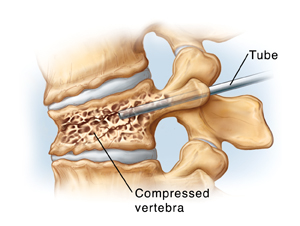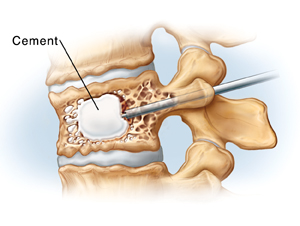Kyphoplasty
Kyphoplasty is a procedure that can help relieve the pain of vertebral compression fracture. This is a collapse of bone in your spine most commonly caused by osteoporosis. It does this by strengthening your spine (vertebrae) with special surgical cement. The procedure usually takes 30 to 45 minutes.
Preparing for the procedure
Tell your healthcare provider about all medicines you take. This includes over-the-counter medicines, herbs, vitamins, and other supplements.
-
Ask your healthcare provider if you should stop taking any medicines, such as blood thinners, before the procedure.
-
Follow any directions you are given for not eating or drinking before surgery.
-
Arrange for an adult family member or friend to drive you home.
During the procedure


Your healthcare provider will give you anesthesia. This is medicine to keep you from feeling pain during the procedure. During kyphoplasty:
-
Your surgeon makes 1 or more tiny incisions in your back.
-
Using live video X-ray images (fluoroscopy) as a guide, your surgeon inserts a hollow tube through the incision (cut) into the collapsed vertebra.
-
A small balloon is passed through the tube into the vertebra. There it's inflated to open a space.
-
Typically, the balloon is then removed, and the empty space is filled with special cement for bones.
Risks and possible complications
Kyphoplasty is considered safe. If complications do happen, they may include:
-
Spinal cord or nerve damage
-
Cement leakage in blood vessels, or against the spinal cord
-
Heart or lung problems
-
New or unrelieved back pain
-
Infection
-
Allergy to the cement (rare)
-
Fractures of the neighboring vertebrae
After the procedure
You will be sent to a recovery room after the procedure. Usually, you will go home later the same day. Or, you may stay the night in a hospital room. Once you’re ready to go home, your healthcare provider will tell you how to care for yourself.
When to call your healthcare provider
Call your healthcare provider right away if any of the following occur:
-
Fever of 100.4° F ( 38.0°C) or higher, or as directed by your healthcare provider
-
New pain, weakness, tingling, or numbness in your legs
-
New or unrelieved back pain